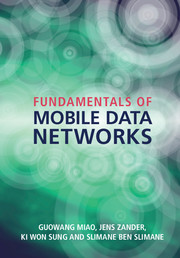Book contents
- Frontmatter
- Contents
- Preface
- Acronyms
- Notations
- 1 Introduction
- 2 Wireless network models
- 3 Medium access control
- 4 Scheduling
- 5 Principles of cellular systems
- 6 Transmitter power control
- 7 Interference management
- 8 Association and handover
- 9 Energy-efficient design
- 10 Long term evolution
- 11 Wireless infrastructure economics
- About the authors
- Index
- References
8 - Association and handover
Published online by Cambridge University Press: 05 March 2016
- Frontmatter
- Contents
- Preface
- Acronyms
- Notations
- 1 Introduction
- 2 Wireless network models
- 3 Medium access control
- 4 Scheduling
- 5 Principles of cellular systems
- 6 Transmitter power control
- 7 Interference management
- 8 Association and handover
- 9 Energy-efficient design
- 10 Long term evolution
- 11 Wireless infrastructure economics
- About the authors
- Index
- References
Summary
If you want to make a phone call or surf the Internet with your mobile device, it must be connected to a base station as a first step. A cellular system consists of thousands of base stations. Thus, it is important to select the base station which can offer the best service quality. This is one of the fundamental radio resource management problems, namely association. When you are moving, the association has to be changed quite often because each base station has a limited coverage. This is termed handover.
In this chapter, we will study some basic problems involved with association and handover. We will start by looking at handover. In Section 8.1, terminology regarding handover types and procedure will be introduced. Then handover decision and resource allocation perspectives will be discussed in Section 8.2 and Section 8.3 respectively. Soft handover will be presented in Section 8.4. Finally, we will discuss association issues in heterogeneous networks (HetNets) in Section 8.5.
Anatomy of handover
Location management and handover
Nowadays, people expect seamless wireless connection while on the move almost everywhere in the world. The support of mobility is one of the main reasons behind the tremendous success of wireless communication systems. Two types of challenge need to be addressed in providing mobility support to users. The first one is keeping track of inactive terminals so that they can respond quickly to requests from the (fixed) network to establish communications with them. This is referred to as location management [V. W.-S. Wong and V. C. M. Leung, 2000]. It is of global scale, and sometimes involves multiple network operators because a terminal may leave the service area of one operator and enter that of another. This is called roaming.
The second challenge arises when an active terminal is moving. Since a base station only covers a limited area, the mobile terminal has a risk of leaving the area where its currently serving base station is capable of providing sufficient QoS. Therefore, mobility support for active terminals in cellular networks is achieved by timely and reliable transitions of serving base stations (handover). It should be performed in real time, and thus is a demanding task, particularly for delay-sensitive applications such as voice or video calls that require continuous service provision with very little loss of data.
- Type
- Chapter
- Information
- Fundamentals of Mobile Data Networks , pp. 199 - 226Publisher: Cambridge University PressPrint publication year: 2016



